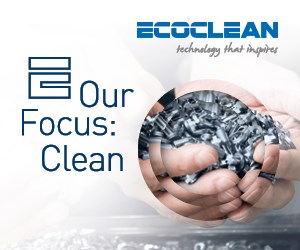Replacing Discontinued Vapor Degreasing Fluids – 3 Things to Consider
What do you do when you learn your trusted line of vapor degreasing cleaning fluids will soon be discontinued? Elizabeth Norwood of MicroCare discusses what you should keep in mind when replacing discontinued vapor degreasing fluids.

Manufacturers should choose a supplier that understands the dynamics between cleaning chemistry and cleaning equipment and has a laboratory support structure to support a smooth transition.
Photo Credit: MicroCare
Q: My vapor degreasing fluid is being discontinued. What should I do?
A: When a manufacturer learns that their trusted line of vapor degreasing cleaning fluids will soon be discontinued, they may be left wondering how to move forward. There are many factors to consider when choosing a replacement cleaning fluid, including the equipment and substrate being cleaned, the type of contamination being removed, the long-term availability of the chosen fluid, and the level of support available from the supplier. Here are the three important factors to consider when replacing discontinued vapor degreasing fluids.
1: Consider your equipment, substrate and contamination
When looking for a replacement cleaning fluid, manufacturers should first identify the type of equipment, substrate and contamination they are dealing with. This will help them narrow down their options and find a cleaning fluid that is tailored to their specific needs. It is also important to work with a supplier who has experience with similar equipment and substrates.
Manufacturers should ask potential suppliers questions about their cleaning fluid’s compatibility with their substrates and equipment. For example, if a manufacturer is cleaning steel parts, they should inquire about the cleaning fluid's ability to protect against corrosion. If a manufacturer is using a specific type of cleaning equipment, they should ask if the cleaning fluid is compatible or if the equipment will require upgrades or modifications.
Additionally, manufacturers should start to prepare for their transition now. This may involve testing new cleaning fluids on a small scale to ensure that they are effective and do not cause any damage to equipment or substrates. It may also involve training employees on how to use the new cleaning fluid and making adjustments to the cleaning process to ensure optimal performance.
2: Know the long-term availability of your chosen replacement fluid
When selecting a replacement cleaning fluid, manufacturers should choose a fluid with a proven track record and a long-term sustainability profile. This means choosing a fluid that has been on the market for a significant amount of time and has a proven record of effectiveness. Manufacturers should also consider the long-term availability of the chosen fluid. If a fluid is only available for a limited time, it may be difficult to find a replacement when it is needed.
Manufacturers should also consider the environmental impact of the chosen fluid. Many newer cleaning fluids are designed to be more environmentally friendly than older ones. This may include fluids that have a low global warming potential, or are free of hazardous air pollutants. Choosing an environmentally friendly cleaning fluid may not only benefit the environment, but also the health and safety of employees who work with the fluid.
3: Determine what support you’ll get for the replacement cleaning fluid after you buy
Finally, manufacturers should choose a supplier that understands the dynamics between cleaning chemistry and cleaning equipment and has a laboratory support structure to support a smooth transition. This means choosing a supplier that offers technical support, troubleshooting and training on the new cleaning fluid. Manufacturers should also choose a supplier that has a long-standing, good reputation for customer service and is available to answer any questions or concerns that might arise.
In conclusion, replacing discontinued vapor degreasing fluids can be a daunting task. However, by considering the equipment, substrate and contamination being cleaned, the long-term availability of the chosen fluid, and the level of support available from the supplier, manufacturers can select a replacement cleaning fluid that provides optimal cleaning performance with the least impact on the environment and their cleaning processes.
About the Author

Elizabeth Norwood
Elizabeth Norwood is a Senior Chemist at MicroCare, LLC, which offers precision cleaning solutions. She has been in the industry for more than 25 years and holds a BS in Chemistry from the University of St. Joseph. Norwood researches, develops and tests cleaning-related products. She currently has one patent issued and two pending for her work. For more information, visit www.microcare.com.
Related Content
Top Shop Emphasizes Dedication, Work Ethic
With a primary focus on aerospace and defense work, American Metaseal Corp. of Arbutus, Maryland, has qualified as a Top Shop on multiple occasions.
Read MoreSolar Atmospheres of Western PA Receives Nadcap Accreditation
The company received the accreditation for it’s new, fully integrated Vacuum Oil Quench furnace, which provides a significantly cleaner and safer oil quenching process.
Read MoreVacuum Degreaser Cleans Up a Messy Situation
By replacing its immersion parts washer with a vacuum degreasing system, this machine shop is much more efficient, saving the company money, man hours and the health of the operators.
Read MoreReplacing Open-Top Vapor Degreasing in Aerospace Manufacturing
Options and considerations for cleaning aerospace parts as regulations tighten on vapor degreasing solvents.
Read MoreRead Next
Episode 42: An Interview with Robin Deal, Hubbard-Hall
Hubbard-Hall wastewater treatment specialist Robin Deal discusses the latest trends in wastewater management.
Read MorePowder Coating 4.0: Smarter, Faster, More Efficient and Connected
New tools reduce cost and waste, lower manufacturing footprint of powder coating operations.
Read MoreThe 2024 Ford Mustang: All the Colors Available
Although Chevrolet has announced the end of the Camaro and Dodge is offering “Last Call” editions of the Charger and Challenger, the Ford Mustang is launching to its seventh generation.
Read More

























